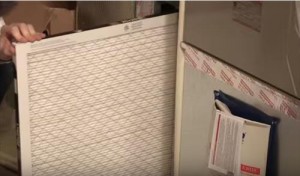
The maintenance for large electrical heating systems may include either panel type, baseboard type, or forced air.
The panel and baseboard systems do not require much maintenance when properly installed.
Baseboard heat has more air circulation over the elements that the panel type, so the units must be kept dust free.
Some areas will have more dust and require cleaning more often. Both panel and baseboard type systems use line voltage thermostats.
These thermostats contain the only moving parts and will normally be the first to fail. These thermostats will collect some dust and must be cleaned inside at some time. Be sure to turn the power off it for servicing.
Central forced air systems have a fan to move the air and consequently require filter maintenance. Filters should be changed or cleaned on a regular basis, depending on the rate of the dust accumulation.
Some fan bearings require lubrication at regular intervals. Motor and fan shafts with sleeve bearings must be kept in good working order because these bearings will not take much abuse.
Lift the motor or fan shafts and look at the movement. Don’t confuse shaft end play with bearing wear. Many motors have up to 1/8 inch, in play.
Some systems may have Bell drives and require belt tension adjustment or belt changing. Frayed or broken belts must be replaced to ensure safe and trouble-free operation.
Belts should be checked at least once a year. It is very dangerous to operate electric heating systems with little or no airflow.
Filter should be checked every 30 days of operation unless it is determined that longer periods may be allowed. Use the filters that fit the holder and be sure to follow the direction arrows on the filter for the correct airflow direction.
When the filter system becomes clogged on a forced air system, the airflow is reduced and causes overheating of the elements. The automatic reset limit switches should be the first to trip and then reset.
If the condition continues, these switches may fell, and the fuse link in the heater may open the circuit. When this happens, the link must be replaced by qualified technician. This requires a service call that could have been prevented.
The electric heating elements are usually controlled by low-voltage thermostats that open or close the contacts on sequencers are contactors. The contacts in the sequencers are contactors carry large electrical loads, which will probably produce the most stress.
They will probably be the first component to fell and improperly maintained system.
You may visually check the contacts on a contactor, but the contacts on sequencers are concealed. When the contacts on a contactor become pitted, change the contacts on the contactor. The condition will only become worse and could then cause other problems namely terminal and wire damage to the circuit.
The only method you can use to check a sequencer is the visually check the wires for discoloration and check this current flow through each circuit with the sequencer energized. If power will not pass through the sequencer circuit, the sequencer may be defective. Don’t forget that the heater must have a path through which electrical energy can flow. Many sequencers have been declared defective only to find out later that the fuse links in the heater or the heater itself has an open circuit.
Line voltage electrical connections in the heater junction box should be examined closely. If there is any wire discoloration or connectors that appeared to have been hot, these components must be changed. The wire is discolored, and it is long enough, it may be cut back until the conductor is its normal color.
Fuse holders may lose their attention and not hold the fuses tightly this is caused from heating and will not be apparent because the fuses will blow when no overload exist and for no other apparent reason. These fuses and holders must be changed for the unit to perform safely and correctly.